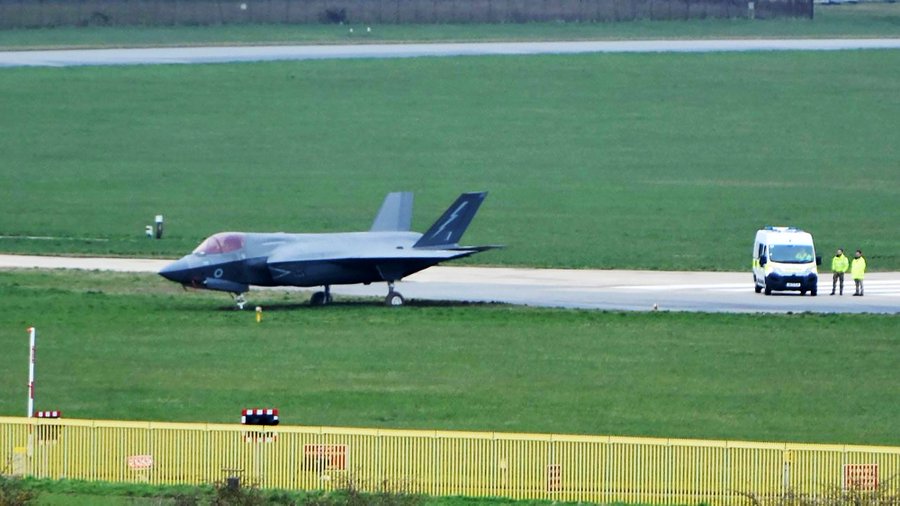The Lockheed Martin F-35 Lightning II fighter jets, arguably the world’s most advanced combat air assets, remain in the limelight owing to one controversy or another. This time, a British F-35 combat aircraft was reportedly involved in a non-fatal incident.

An image recently surfaced on the internet showing a British F-35 Lightning II with its nose wheel stuck in the mud. Social media posts suggested that the aircraft rolled off the runway at the Royal Air Force Marham Airbases home to the F-35 Lightning 5th Generation, multi-role, stealth fighter.
Even though there was no official confirmation from the RAF or the UK Ministry of Defense (MoD) at the time of writing this report, this is not the first time that an image showing an F-35 nose down has appeared on the internet and gone viral.
In December 2022, an F-35B Lightning II fighter jet was photographed parked in Okinawa, Japan, with its nose down on the road. It reportedly suffered a nose landing gear collapse at Kadena Air Base while being towed following an emergency/precautionary landing.
At the time, the aircraft’s nose wheel collapsed while towing, prompting the precautionary landing. The plane’s front wheels broke off while being towed, causing the nose to crash to the ground.
Later that same month, an F-35B suffered a nose dive and swirled after briefly touching down on the shared runway at Naval Air Station Joint Reserve Base in Fort Worth. The jet made its initial touchdown, then bounced back into the air before making a hard nose-first landing on the runway.
With no explanation forthcoming from Marham, speculations have been swirling on social media on the cause of the British F-35 appearing nose-down in the mud. The real cause would be known only when the British officials open up, given that the incident indeed took place.
EurAsian Times had previously noted that landing nose-down can also put a lot of strain on the overall airframe of the aircraft besides impacting the radar of the aircraft and many of the jet’s critical avionics housed in the nose of the jet.
In a typical scenario, pilots use the jet’s tail hook to try to stop the aircraft, a common procedure in many instances where the stability of a fighter’s gear is unknown.
As noted, the F-35s have been in several mishaps and controversies over the years since they became operational. However, one incident involving the RAF F-35 fighter jet that shook the world in 2021 merits a separate mention.
The Tale Of A Narrow Escape!
Earlier this year, British media BBC News published a series called The Warship: Tour of Duty. The series included the story of a miraculous escape by a fighter pilot of the Royal Air Force F-35 that crashed in November 2021.
On November 17, 2021, UK fighter jet F-35 from the Queen Elizabeth aircraft carrier crashed during a routine flying operation in the Mediterranean Sea while the pilot ejected safely.
“A British F35 pilot from HMS Queen Elizabeth ejected during routine flying operations in the Mediterranean this morning. The pilot has been safely returned to the ship,” the ministry said on Twitter.
An official investigation launched in the aftermath of the crash concluded that a cover left on one of the aircraft’s jet intakes was probably what caused the rapid loss of power during takeoff. Speaking soon after the incident in November 2021, the pilot, known as Hux, recalled having only seconds to react.
The Royal Navy pilot was still dealing with scratches and bruises from the high-speed ejection when he met with the filmmakers shortly after being rescued. Describing how the aircraft suddenly lost acceleration, he told the filmmakers: “I tried for emergency power – that didn’t work, then I tried to slap on the brakes – that didn’t work either… so I kind of knew it was going to roll off the ship.”
In addition to a whole lot of luck, his ejector seat, which he claims to be the most sophisticated in the world, saved Hux’s life. He claims that as soon as his parachute opened, he could see the flight deck of the ship starting to appear beneath him after first seeing the sea.

He narrowly avoided being dragged to the sea by a few feet before making it onto the deck. He would have run the risk of getting under the 65,000-tonne warship if he hadn’t landed on the carrier.
A former officer of the RAF Navy, Commander Tome Sharpe, said at the time of the incident, “Given how close the aircraft ditched to the bow, and the speed of the ship on launch, the likelihood of it hitting the bow of the ship (under the waterline) would be quite hi.”
According to a formal investigation, the rapid loss of power was most likely brought on by a blockage—a cover that was inadvertently placed on a jet intake.
The aircraft, which is the most sophisticated stealth fighter in the world and is flown by both the Royal Navy and the Royal Air Force in the UK, was later recovered from the ocean floor to prevent it from ending up in the wrong hands.
The F-35 incident was “a shock to everyone,” according to filmmaker Chris Terrill, who added that the crew’s reaction was “as immediate as it was extraordinary.”
“An aircraft might have been lost, but there was a pilot, a shipmate, who had to be saved,” he said. “Training kicked in, but there was extra energy and urgency to the sailors’ execution of their emergency procedures. It was terrifying but inspiring to see.”
- Contact the author at sakshi.tiwari9555 (at) gmail.com
- Follow EurAsian Times on Google News




